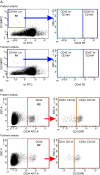Circulating hematopoietic stem cell count is a valuable predictor of prematurity complications in preterm newborns
- PMID: 22985188
- PMCID: PMC3573966
- DOI: 10.1186/1471-2431-12-148
Circulating hematopoietic stem cell count is a valuable predictor of prematurity complications in preterm newborns
Abstract
Background: The frequency of preterm labour has risen over the last few years. Hence, there is growing interest in the identification of markers that may facilitate prediction and prevention of premature birth complications. Here, we studied the association of the number of circulating stem cell populations with the incidence of complications typical of prematurity.
Methods: The study groups consisted of 90 preterm (23-36 weeks of gestational age) and 52 full-term (37-41 weeks) infants. Non-hematopoietic stem cells (non-HSCs; CD45-lin-CD184+), enriched in very small embryonic-like stem cells (VSELs), expressing pluripotent (Oct-4, Nanog), early neural (β-III-tubulin), and oligodendrocyte lineage (Olig-1) genes as well as hematopoietic stem cells (HSCs; CD45+lin-CD184+), and circulating stem/progenitor cells (CSPCs; CD133+CD34+; CD133-CD34+) in association with characteristics of prematurity and preterm morbidity were analyzed in cord blood (CB) and peripheral blood (PB) until the sixth week after delivery. Phenotype analysis was performed using flow cytometry methods. Clonogenic assays suitable for detection of human hematopoietic progenitor cells were also applied. The quantitative parameters were compared between groups by the Mann-Whitney test and between time points by the Friedman test. Fisher's exact test was used for qualitative variables.
Results: We found that the number of CB non-HSCs/VSELs is inversely associated with the birth weight of preterm infants. More notably, a high number of CB HSCs is strongly associated with a lower risk of prematurity complications including intraventricular hemorrhage, respiratory distress syndrome, infections, and anemia. The number of HSCs remains stable for the first six weeks of postnatal life. Besides, the number of CSPCs in CB is significantly higher in preterm infants than in full-term neonates (p < 0.0001) and extensively decreases in preterm babies during next six weeks after birth. Finally, the growth of burst-forming unit of erythrocytes (BFU-E) and colony-forming units of granulocyte-macrophage (CFU-GM) obtained from CB of premature neonates is higher than those obtained from CB of full-term infants and strongly correlates with the number of CB-derived CSPCs.
Conclusion: We conclude that CB HSCs are markedly associated with the development of premature birth complications. Thus, HSCs ought to be considered as the potential target for further research as they may be relevant for predicting and controlling the morbidity of premature infants. Moreover, the observed levels of non-HSCs/VSELs circulating in CB are inversely associated with the birth weight of preterm infants, suggesting non-HSCs/VSELs might be involved in the maturation of fetal organism.
Figures





Similar articles
-
Circulating endothelial progenitor cells in premature infants: is there an association with premature birth complications?J Perinat Med. 2012 Mar 22;40(4):455-62. doi: 10.1515/jpm-2011-0199. J Perinat Med. 2012. PMID: 22752779
-
Circulating stem cell populations in preterm infants: implications for the development of retinopathy of prematurity.Arch Ophthalmol. 2010 Oct;128(10):1311-9. doi: 10.1001/archophthalmol.2010.221. Arch Ophthalmol. 2010. PMID: 20938001
-
Hematopoietic stem cells in neonates: any differences between very preterm and term neonates?PLoS One. 2014 Sep 2;9(9):e106717. doi: 10.1371/journal.pone.0106717. eCollection 2014. PLoS One. 2014. PMID: 25181353 Free PMC article.
-
Umbilical cord blood-derived very small embryonic like stem cells (VSELs) as a source of pluripotent stem cells for regenerative medicine.Pediatr Endocrinol Rev. 2012 Mar;9(3):639-43. Pediatr Endocrinol Rev. 2012. PMID: 22523831 Review.
-
Very small embryonic/epiblast-like stem cells (VSELs) and their potential role in aging and organ rejuvenation--an update and comparison to other primitive small stem cells isolated from adult tissues.Aging (Albany NY). 2012 Apr;4(4):235-46. doi: 10.18632/aging.100449. Aging (Albany NY). 2012. PMID: 22498452 Free PMC article. Review.
Cited by
-
Mobilization of circulating progenitor cells following brain injury in premature neonates could be indicative of an endogenous repair process. A pilot study.Hippokratia. 2015 Apr-Jun;19(2):141-7. Hippokratia. 2015. PMID: 27418763 Free PMC article.
-
Epigenetic and Transcriptomic Programming of HSC Quiescence Signaling in Large for Gestational Age Neonates.Int J Mol Sci. 2022 Jun 30;23(13):7323. doi: 10.3390/ijms23137323. Int J Mol Sci. 2022. PMID: 35806330 Free PMC article.
-
Kinetics of Circulating Progenitor Cells and Chemotactic Factors in Full-Term Neonates with Encephalopathy: Indications of Participation in the Endogenous Regenerative Process.Biomolecules. 2025 Mar 17;15(3):427. doi: 10.3390/biom15030427. Biomolecules. 2025. PMID: 40149963 Free PMC article.
-
Preeclampsia and Inflammatory Preterm Labor Alter the Human Placental Hematopoietic Niche.Reprod Sci. 2016 Sep;23(9):1179-92. doi: 10.1177/1933719116632926. Epub 2016 Mar 3. Reprod Sci. 2016. PMID: 26944948 Free PMC article.
-
Beyond brain injury biomarkers: chemoattractants and circulating progenitor cells as biomarkers of endogenous rehabilitation effort in preterm neonates with encephalopathy.Front Pediatr. 2023 May 24;11:1151787. doi: 10.3389/fped.2023.1151787. eCollection 2023. Front Pediatr. 2023. PMID: 37292373 Free PMC article.
References
-
- Paczkowska E, Kucia M, Koziarska D, Halasa M, Safranow K, Masiuk M, Karbicka A, Nowik M, Nowacki P, Ratajczak MZ, Machalinski B. Clinical evidence that very small embryonic-like (VSEL) stem cells are mobilized into peripheral blood in patients after stroke. Stroke. 2009;40:1237–1244. doi: 10.1161/STROKEAHA.108.535062. - DOI - PubMed
Publication types
MeSH terms
Substances
LinkOut - more resources
Full Text Sources
Medical
Research Materials
Miscellaneous

